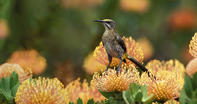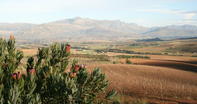A Necessary Evil
Without fire, fynbos becomes aged and barren, so it is a necessary evil. Before human settlement in the region, blazes easily raged across millions of hectares of fynbos. The lightning that accompanied the thunderstorms of late summer and early autumn would have struck the vegetation, left tinder-dry by the hot summer months when humidity was low and soil moisture depleted.

This happens every four to 45 years or so but averaged out at every twelve to fifteen years. The charred and blackened landscapes left behind by fires give them a reputation for being destructive. But fires bring new life, like rain in the desert. Fynbos is honed by this adversity. Drought conditions and nutrient-poor soils have evolved these plants into small and twiggy runts.
When fire sweeps through fynbos, the low fuel load produces a specific kind of fire - one that is mild and cool compared with the inferno associated with heavily-wooded forests. As they eat their way through the fynbos, flames split open seed pods, prune back proteas and release seeds buried by ants for safe keeping. From the ashes, seedlings sprout, shrubs send out new, fresh growth and bulb plants throw up magnificently coloured pillars of flowers. Few fynbos plants are not triggered by fire to reproduce.
More recently, it's been discovered that many seeds don't just need fire but the smoke from fire in order to switch off their dormancy. Heat from the fire breaks the seed casings and triggers growth - ethylene and ammonia in smoke stimulate some seeds to germinate.
More specifically, the chemicals present in smoke derived from burned fynbos trigger the plant embryos to burst into growth. Cooling autumnal nights, smoke taint and the first dashes of the seasonal rain start the germination of seeds that are adapted to respond to this specific three-part trigger.
The Lost Plant

Already one-third of fynbos has been lost to agriculture, development or alien plants. As if that's not enough, global warming is turning the region into a great powder keg.
The temperature increase predicted for the area by computer climate modelling is still being refined, but an increase of about 1.5°C can be expected along the coast with a 2°C to 3°C increase occurring within the interior of the province's coastal mountains. Pinning down the exact change in rainfall is not quite that easy, but the consensus points to a shift in the patterns of rainfall in the region. Winter rainfall will decrease, and will probably fall later in the season.
Early modelling put this seasonal decline at 25 per cent. An increase in summertime humidity is expected to bring a little more rain in the late summer to the east and interior. The westerly storm tracks, responsible for the province's winter rainfall, are expected to shift southwards. This means that many of the fronts we need to bring the Cape's winter rainfall will head off out over the ocean, failing to bring the rain which, for millennia, has helped to drive evolution in these parts.
The Cape Fold Mountains are the region's rainmakers. As the left-over stumps of gnarled and twisted rock cut high into the face of seasonal winds, they force air upwards, cooling it suddenly and coaxing moisture from it. The modelling predicts an increase in this 'orographic' rain to the higher mountain tops.
The picture is still a bit fuzzy, but one thing is clear - the region is going to become hotter and drier with a greater intensity of extreme events such as drought, heat waves, sweeping berg winds and late-summer flooding. As for the animals living in fynbos, most of the larger game - black rhino, gemsbok, mountain zebra - were hunted out of the region by the time my grandparents were born.
But there's still a smorgasbord of little creatures that are as unique to the vegetation as fynbos is to the region. Take the Cape sugarbirds. They flit around the fynbos, snacking on insects and drinking nectar from the woody cups of the larger protea flowers. Hurrying from bush to bush, their heads dusted with pollen, they are among the great protea pollinators of the Cape.
By Leonie Joubert